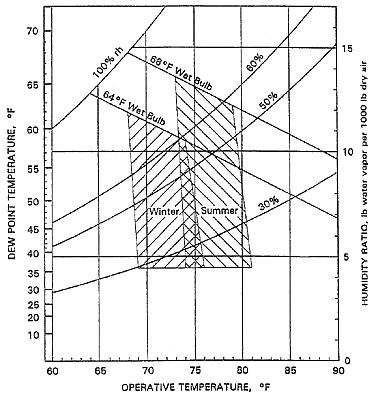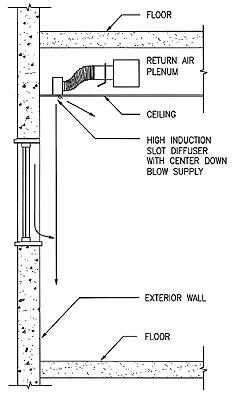- Too hot;
- Too cold;
- Too drafty;
- Too stuffy;
- It smells; and
- It’s noisy.
Review of the original system design and how the system is to be operated can address all these complaints. This article shall address the concerns one at a time, pointing out the engineering, construction, and operational basics to be considered.
Too Hot
No system can produce thermal comfort for everyone; however, American Society of Heating, Refrigerating and Air-Conditioning (ASHRAE) has conducted research to establish acceptable ranges of summer and winter comfort to satisfy most people in an office environment. Note in Figure 1, ASHRAE Summer and Winter Comfort Zones, that there is an overlap between the summer and winter ranges. The ideal thermostat selection is applicable for both the heating and cooling seasons because no one wants to reset all the zone thermostats for seasonal changeover. The summer design intent is to dehumidify to below 50% rh, and the winter design intent is to keep the rh above 30%. If you select a thermostat setting of 74˚F, and have a system that will dehumidify to at least 50% rh, “Too Hot” should not be a problem. As a final check, verify the calibration of the thermostats and narrow the dead band of control to plus or minus 1˚F.
Too Cold
This can be both a summer and winter complaint. The summer complaint is often due to the low setpoint of the thermostats. Building operators remember the ‘Energy Crisis’ mandated a setpoint of 72˚F. Remember that this was a heating setpoint for energy conservation. Most buildings of today have zone Variable Air Volume (VAV) control systems, and the primary function of this type of system is to provide zoned cooling. Therefore, the VAV system is cooling the facility down to 72˚F, not heating to this setpoint. A space temperature of 72˚F, is at the lower extreme of the ASHRAE Comfort Zone.The topic of minimum ventilation also plays into this scenario. The ASHRAE Standard 62-1989 requires 20 cfm of outdoor air to the occupants. This ventilation requirement leads to minimum cfm quantities supplied to the VAV boxes. If cooling loads or reheats are not provided, the space will overcool, thus resulting in too cold complaints.
“Too Big” is also a contributor to this too cold problem. Oversized diffusers will dump cold air on the heads of the occupant when the VAV box throttles back in response to less than peak cooling loads. A good rule of thumb is to limit the neck size of the diffuser (in inches) to the ceiling height of the space (in feet). Example: 9-in. diffuser neck in spaces with 9-ft ceilings. This is another case for the value of slot diffusers with their small necks and high induction capabilities.
The summer system discharge temperature needs to be cold enough leaving the cooling coil to dehumidify the airstream. The traditional discharge temperature is 55˚F. This temperature will rise if the system has chilled water control problems or the DX system is low on refrigerant. A system check is necessary to monitor the discharge temperature at the air handler to be sure that the system is dehumidifying in the summer.
The winter system discharge temperature can be in the 60˚-63˚F range. This provides enough cooling temperature differential to cover the heat gains.
A Compromise for Thermostat Setpoint
The traditional office workforce today is a gender and a cultural mix. One solution does not fit all. ASHRAE has recognized the gender difference and has created Comfort Zone tables for both men and women. These facts explain the comfort battle between the sexes, but they do not solve the problem. Men like it cool, and women like it warm. Experience has shown that if cooling the space controls the rh, a setpoint of 75˚F minimizes the hot-cold calls. Note that the 75˚F recommendation is a shift from the too hot setpoint.
Too Drafty
Sidewall distribution will always create a draft at some location. Try to avoid locating a fixed workstation in a sidewall supplied space.Proper selection of diffusers is important to satisfy the comfort expectations of the occupants. If diffuser zones (large diffuser neck sizes) are too large in a VAV system, the diffusers will not mix the air in the space using the principle of induction at the diffuser. The result is that cold air “falls” on the occupants as a draft. Also, a diffuser location too near a wall or other vertical obstruction will result in a downflow of the air causing a draft.
The selection and sizing of diffusers should be based on the acceptable air diffusion performance index (ADPI). The designer should become familiar with the diffuser selection material in the ASHRAE Handbook-Fundamentals, Chapter 31 and use the information as a guide.
Perimeter or exterior zones of a building are also prime targets of draft complaints. In cold climates the cold air falls downward off the glass surface. The cold will hit the window sill and be channeled toward a nearby occupant. Wall fin radiation was the traditional remedy for this problem. With the advent of cube workstations and value-engineered systems, the heat is either in the ceiling or in the warm air system blowing warm air down into the occupied space. Warm radiant ceiling panels are a replacement for the wall fin radiation, however cold air spilling from a window sill is still a problem. A constant supply of warm air from the perimeter ceiling heating-cooling slot diffuser can temper the cold window air at the window sill level. Figure 2 indicates the flow direction from the overhead perimeter diffuser that has been tested in mockups to result in the least draft complaints.
Too Stuffy
Not enough air being supplied into a space results in this complaint. The problem is most often a winter case. The traditional cause is the airflow being reduced in a VAV system with pinch-off boxes. If little or no cooling is called for, the VAV box goes to a no-flow condition. The simple solution is to raise the discharge temperature, which in turn reduces the cooling capacity of the system. The reduction in cooling capacity requires more air to cool the space load. Another solution is to provide heating (reheat) coils on the VAV terminal. A too high setpoint in a pinch-down type VAV system can also turn off the supply air to the space. Remember that the traditional VAV system only cools. Heating in a traditional VAV system is produced by the absence of cooling.Smells
Odor contaminants are from either inside the space or come through the air distribution system. Most offices have a break or beverage area with a microwave oven. The major odor source, outside of the lunch period, is microwave popcorn. The oil or butter in the popcorn carries throughout the ceiling plenum return to all the office areas. The solutions are to either ban the popcorn or to exhaust the break area. The other interior controllable odor sources are the cleaning supplies, new paint, new carpet, etc. Anything that is going to be “new” should be evaluated to minimize the smell problem. A musty smell indicates a marriage of dirt and moisture. The moisture may be from water leaks, standing water in drain pans, rain/snow in the unit odor ductwork, or residual from a water overflow.
The boosted domestic water pump losing its pressure control and going to full pressure at night caused a recent case of a water flood in a high-rise office building. The relief valves released on the tenant electric water heaters. The relief flow soon overpowered the water heater drain pan and its drain line and water flooded onto the tenant floors. The carpet was soaked, as well as an indication on the wall that the water level was 2 in. deep. The floors were vacuumed, dried and deemed to be cleaned up; however, based on experiences with spring flood damage, it was suggested to open up the wall cavity to look for potential future mold problems. Water was found to be standing in the stud track and the sound batting in the wall was damp. Mold had already started to form in the wall cavity. A 6-in. strip of drywall was removed, the damp sound batts replaced, and the cavity was dried out before repairs were finished.
Noise
Velocity noise at ceiling terminals is often “fixed” by the tenant with paper, tape, or rags in the outlet. A damper that has been squeezed closed causes the noise. The damper was closed to solve the “too hot” or “too cold” problem. The proper solution is to solve the original problem rather than applying a “band-aid” to the symptom. Any time a damper is required to balance the airflow, locate the damper at the branch takeoff rather than at the diffuser terminal.Noise is also a good design feature in an open office arrangement. Design the air system to provide at least a level of NC 35. At this level, the air velocity produces a masking background noise to cover conversation and phone distractions.
Another step in the IAQ process is to upgrade the filter efficiency. The higher efficiency filters cost more but they last longer, therefore, the cost should not be a deterrent.
